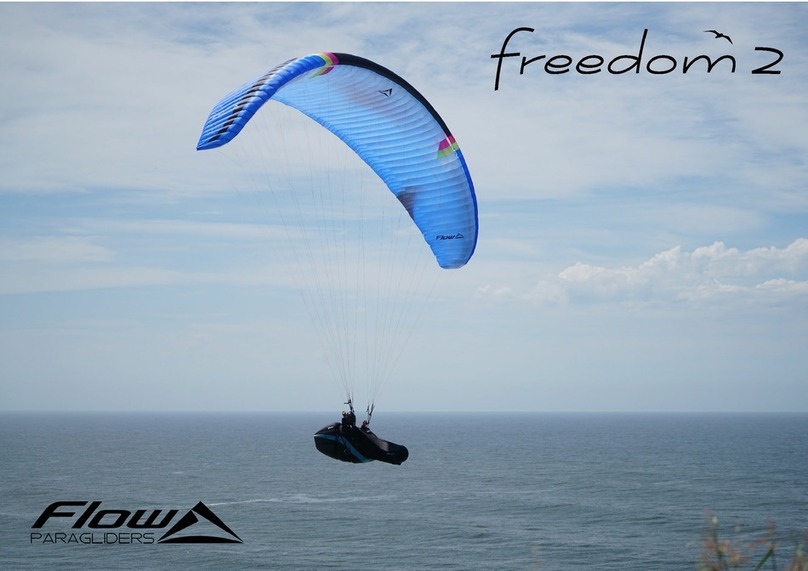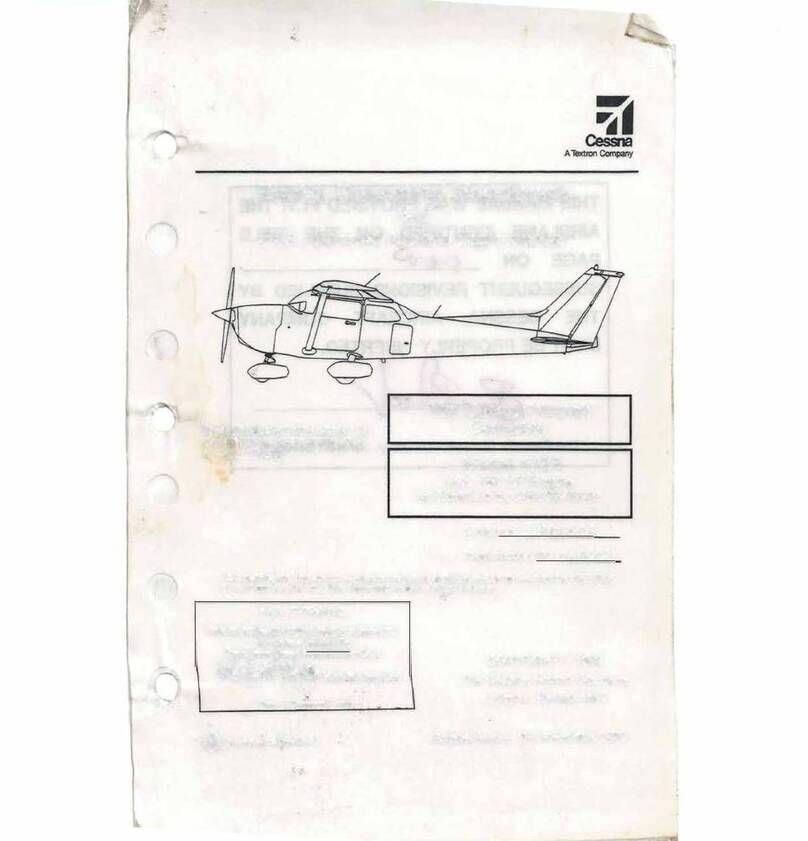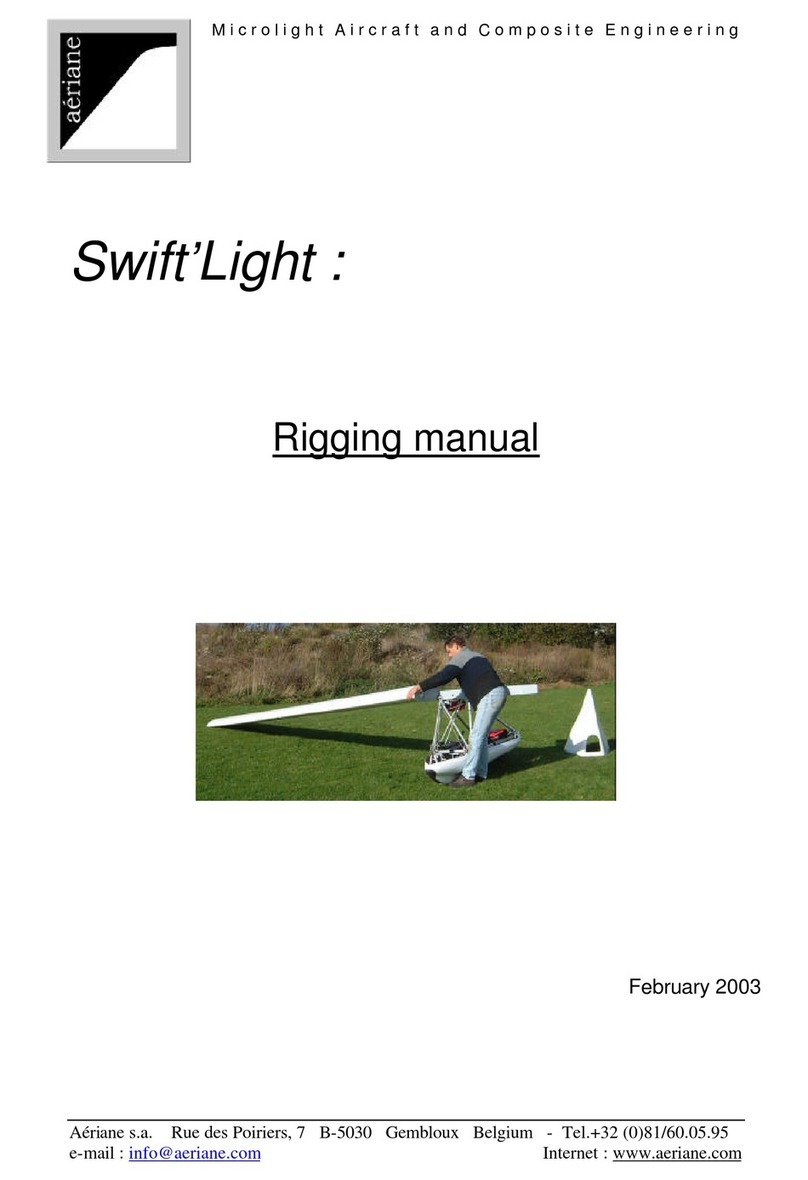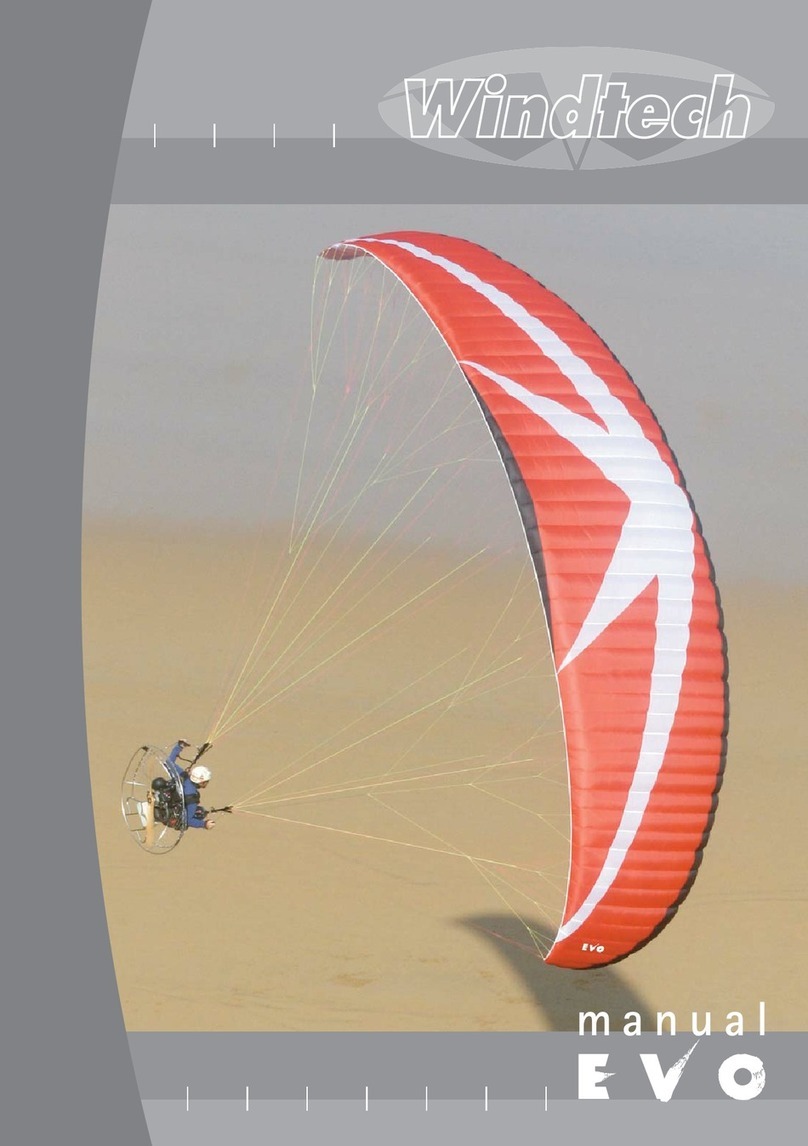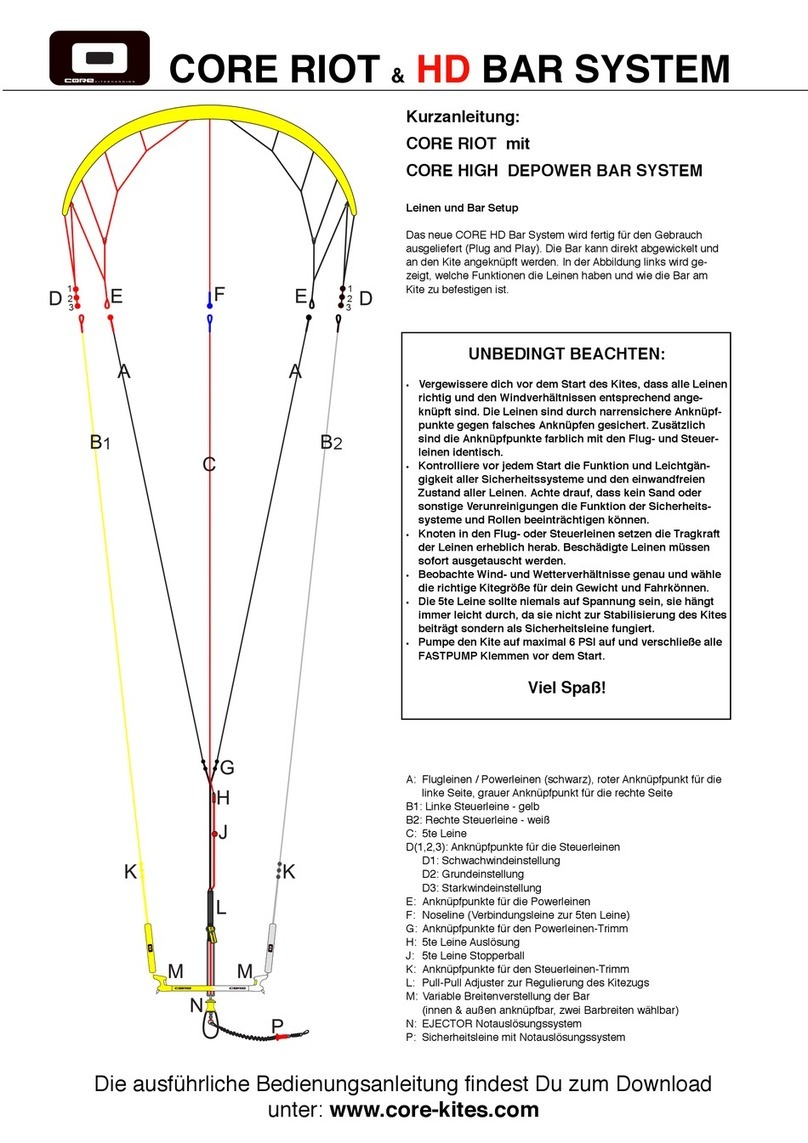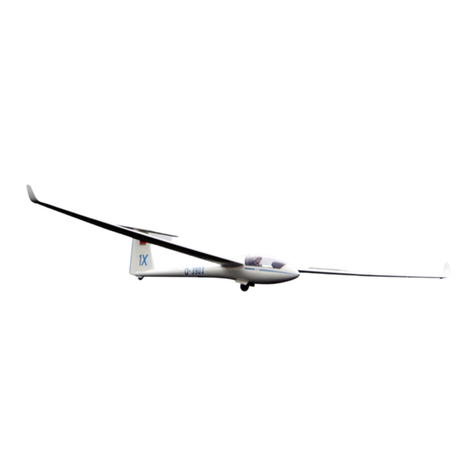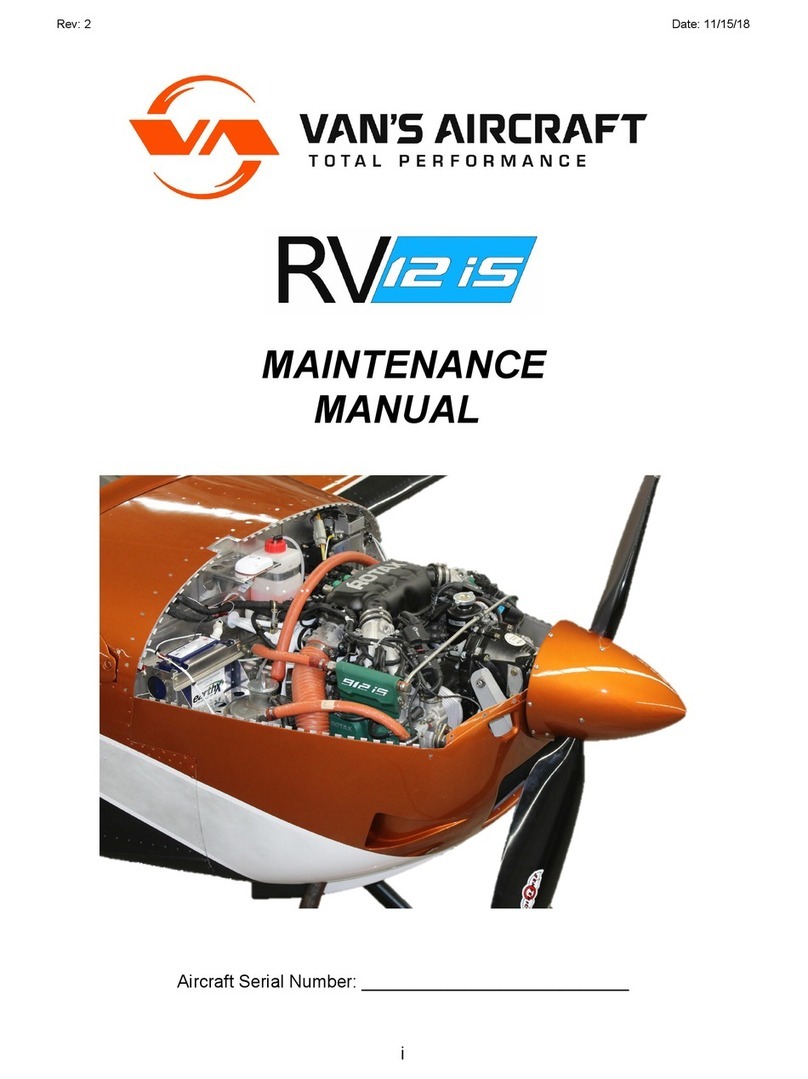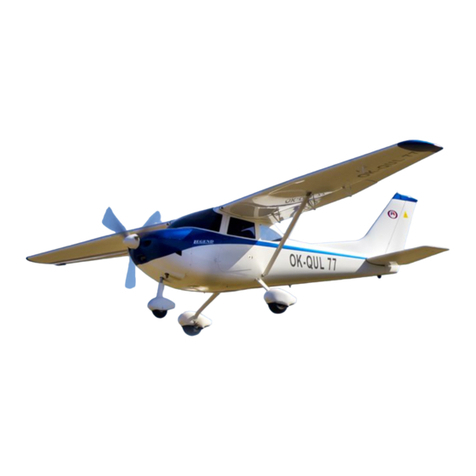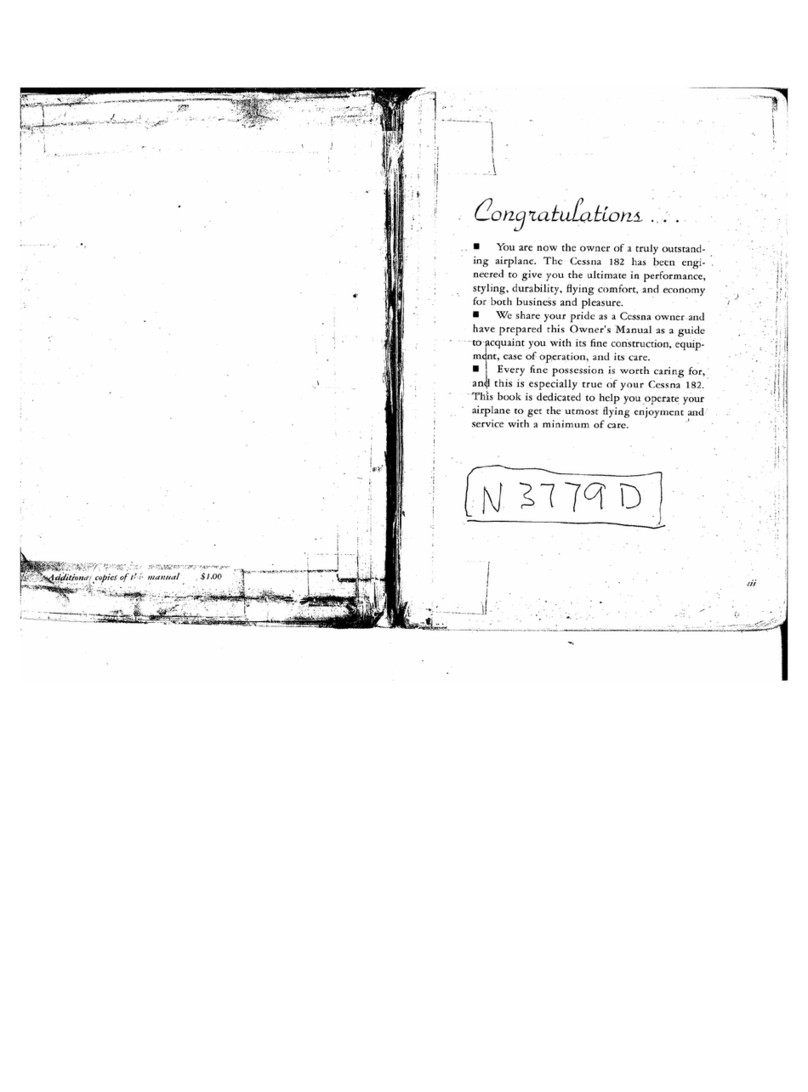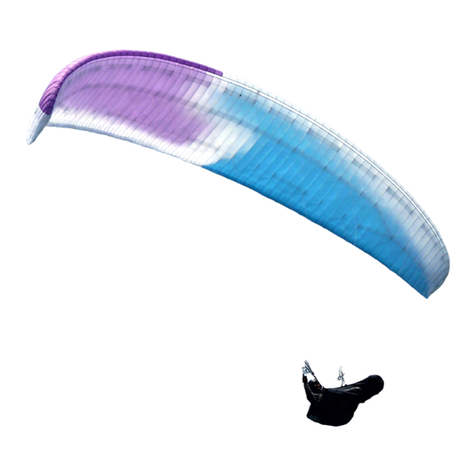Flow Paragliders Cosmos Power Series User manual


WELCOME
“Flow is a term used to describe the complete (body-mind-soul) feeling of being so totally engaged in an activity that there
is a sense of complete immersion in the experience. Self-conscious thoughts give way to feeling at one with the activity and
the environment, and time is no longer an ever-present consideration.”
The experience of flying a paraglider is what inspires us. The pure, focused concentration, the feeling of complete immersion with the
environment and the intrinsic pleasure in the activity itself are all sure signs of the flow experience.
Thank you for flying Flow Paragliders. We recommend that you read this manual before the first flight. This manual is designed to help you to
quickly familiarize with this beautiful glider.

Table of Contents
1. General Information ............................................................................................ 1
2. Your Cosmos Power ............................................................................................. 2
3. Design Overlook ................................................................................................... 3
4. Specifications ....................................................................................................... 4
5. Take-off and Flying Techniques ............................................................................ 5
5.1. Hang-Point..........................................................................................................5
5.2. Before Take-off ..................................................................................................5
5.3. Take-off .............................................................................................................5
5.4. Turning ..............................................................................................................6
5.5. 2D Tip Steering Control .....................................................................................6
5.6. Landing ...............................................................................................................6
6. Flight Envelope and Limitations............................................................................ 7
6.1. Trike Flying .........................................................................................................7
6.2. Free-Flying .........................................................................................................7
6.3. Towing................................................................................................................7
6.4. MTOW ................................................................................................................7
7. RISERS OVERVIEW ................................................................................................ 8
7.1. Speed Bar System ............................................................................................. 9
7.2. Trimmer System ..............................................................................................10
7.3. Trimmer Settings .............................................................................................11
7.4. Neutral Trim ....................................................................................................12
7.5. Fast Reflex Trim mod 01 .................................................................................13
7.6. Fast Reflex Trim mod 02 .................................................................................14
7.7. Fastest Full Reflex Trim ...................................................................................14
8. The “Sweet Spot” for XC .................................................................................... 15
9. 2D Tip Steering .................................................................................................. 16
9.1. 2D Tip Steering Mod Instructions ...................................................................18
10. Riser Safety ........................................................................................................ 21
11. Flying techniques................................................................................................ 22
11.1. Rapid Descent ..........................................................................................22
11.2. Spiral Dive.................................................................................................22
11.3. B-Line Stall................................................................................................22
11.4. Big Ears.....................................................................................................22
11.5. Use of brakes ...........................................................................................23
11.6. Use of Speed Bar......................................................................................23
11.7. Asymmetric Collapse ...............................................................................23
11.8. Frontal (Symmetric) Collapse..................................................................24
11.9. Full Stall ....................................................................................................24
11.10. Flying Without Brakes..............................................................................25
11.11. Cravats......................................................................................................25
11.12. SIV.............................................................................................................25
12. Maintenance & Checks....................................................................................... 26
12.1. Maintenance Tips ....................................................................................26
12.2. Periodic Inspections.................................................................................26
13. Warranty ............................................................................................................ 27
14. Summary ............................................................................................................ 27
15. Line Plan ............................................................................................................. 28
16. Riser Diagram ..................................................................................................... 29
17. Overall Illustration.............................................................................................. 30
18. Materials ............................................................................................................ 31

1
1. General Information
User manual for Cosmos Power
Sizes: 19, 22, 24 & 26
This manual offers all the necessary information that will familiarize you with the main characteristics of your new glider. Although this manual
informs you about your glider, it does not offer the instruction requirements necessary for you to be able to pilot this type of wing. Flying instruction
can only be taught at a paragliding school recognized by the flying federation of your country. Nevertheless, we remind you that it is important
that you carefully read all the contents of the manual for your new Cosmos Power.
The Cosmos Power has been DGAC certified, having met all the requirements of EN 926-1.
Please note that any changes to the glider will invalidate the result of the certification. Correct usage of the glider is the pilot‘s responsibility. The
manufacturer and distributor do not accept liability for loss or damage as a result of the misuse of this glider. It is the pilot’s responsibility to
comply with legal regulations and to maintain the airworthiness of the aircraft.
This user manual version V01 is dated: 04/2021.

2
2. Your Cosmos Power
Cosmos Power is a dedicated intermediate paramotor wing. It shares the same line layout, AR and materials as our free-flying EN B Cosmos. Cosmos
and Cosmos Power are 2 different wings. Cosmos Power is a completely new design, specially made for intermediate ppg pilots.
•STABILITY
•EASE OF USE
•EFFICIENCY
Extremely efficient and stable, especially in all configurations.
3. Design overlook
A highly efficient and extremely stable, intermediated paramotor wing. With state of the art “Efficient full reflex”, shark nose aerofoil, optional 2D tip
steering, trimmers and speed bar.
Cosmos Power is a very efficient and fun glider to fly. Designed as fully dedicated ppg glider that can also be used for free-flight and paramotoring.
Cosmos Power offers remarkable pitch stability and efficiency due to our “efficient full reflex” profile and low-drag line plan. The new airfoil combined
with modern technological advancements represents the forefront in paramotor glider design as it brings benchmark fuel efficiency, stability and
speed in one package.
We say “efficient” because of the full reflex traditionally used in ppg wing designs, is not an efficient airfoil by any means. However, we have managed
to combine some of the key elements of our high-end free-flying gliders and technology into our full reflex paramotor profile, making it extremely
efficient and stable.
The result is in an incredibly efficient airfoil with the same outstanding levels of pitch stability found on full reflex gliders.

3
Cosmos Power’s airfoil not only gives increased levels of safety and stability also increased efficiency at extremely high AoA when flying at speed.
In real-life tests, our paramotor wings have shown unprecedented efficiency levels (fuel consumption) at low and top-end speeds when compared to
traditional non-reflex wings and full-reflex wings.
In a nutshell, Cosmos Power is a nimble glider that is easy to inflate and launch in both nil wind and high wind days. Cruising at trim or at speed the
pilot will notice increased stability in all configurations. Equipped with trimmers, speed bar and tip steering, it is easy to explore the full potential of this
glider. Cosmos Power is also very roll-stable, and no oscillations are present. Landings are easy and facilitated due to the glider’s ability to convert its
energy retention into a predictable and reassuring flare.

4
4. SPECIFICATIONS
19
22
24
26
FLAT AREA
19.00m2
22.00m2
24.00m2
26.00m2
PROJECTED AREA
16.46m²
19.06m2
20.79m2
22.52m2
FLAT WINGSPAN
9.98m
10.74m
11.22m
11.68m
PROJECTED SPAN
8.23m
8.85m
9.25m
9.62m
ASPECT RATIO
5.25
5.25
5.25
5.25
PROJECTED AR
4.1
4.1
4.1
4.1
NUMBER OF CELLS
50
50
50
50
GLIDER WEIGHT
4.1kg
4.3kg
4.6kg
5.0kg
TAKE OFF WEIGHT INTERMEDIATE
75-105
85-115
95-125
100-135
EXTENDED TAKE OFF WEIGHT
ADVANCED
75-130
85-140
95-150
100-160
CERTIFICATION
EN 926-1/
DGAC*pending
EN 926-1/
DGAC*pending
EN 926-1/
DGAC*pending
EN 926-1/
DGAC*pending

5
5. TAKE-OFF, FLIGHT, AND FLYING TECHNIQUES
We know that for the PPG pilot, the take-off and landing phase are crucial, and Cosmos Power’s design is such that launching and landing are both
straight forward and predictable. Cosmos Power’s good efficiency allow for low take-off and landing speeds with good flare characteristics and
short take off distances. Cosmos Power is damped in both roll and pitch with a good speed range, making it ideal for relaxed cruising flights.
5.1 Hang point
Select the appropriate hang point (upper or lower) according to your harness/power unit system, connect to your power unit and adjust the brake
line length accordingly (standard or +10cm from standard).
From the factory Cosmos Power is setup as a mid-hang point. Both main brake line and tip steering line are setup perfectly for that setup.
•For a high hang point setup make sure you lengthen the brake lines by about 3cm (main brake line and tip steering line).
•For a low hang point setup make sure you shorten the brake lines by about 3cm (main brake line and tip steering line).
5.2 Before Take-off
•Check the canopy for rips or tears. Also, inspect the internal structure (ribs, diagonals) and seams.
•Check if lines are not damaged or tangled.
•Check if the quick links connection between lines to the risers are undamaged and tightened.
•Check if the risers are not damaged or twisted.
•Check if the speed system works freely and that the lines are long enough.
•Check that the brake handles are correctly attached and that each line runs freely through the pulley.
5.3 Take-off
•Lay the paraglider out with the leading edge in a horseshoe shape.
•The glider should be trimmed “neutral” with the rear riser system pulled shut (see trimmer section below). With the trimmer system fully
closed the aero foil is at its most efficient and at its slowest speed.
•Hold the A risers close to the quick links and move forward until the lines get stretched. You should now be perfectly centred with your
wing. With no wind or light headwind, with lines stretched, Cosmos Power inflates rapidly and rises over your head with some dynamic
steps. We recommend that you do not pull risers too forward or down, which could cause a collapse of the leading edge, but simply follow
them until the glider reaches its angle of flight. It is important that the centre of gravity of your body stays in front of your feet during the
inflation of the glider to constantly load the risers. A controlled inflation allows you to check the canopy and lines during the last phase as

6
it comes up and thus avoids the need to use brakes. Depending on the wind conditions a gentle and adequate use of brakes can help you
to take-off quicker.
5.4 Turning
Cosmos Power is designed to turn efficiently and will turn without the need for weight-shift piloting if you choose.
•Cosmos Power is designed to be responsive in turns. Trimmers in neutral the turns are docile and predicable; trimmers in “FAST” the turns
are dynamic and carry energy, take it slowly in flying with trimmers fully open to familiarize yourself with the behaviour in different
configurations.
•Cosmos Power can also be flown slowly for efficient climb and to maintain a flatter turn to minimize sink rate during the turn (with 15%
brake).
•Whilst in fully accelerated mode, (full speed bar- & full out trimmers or just full speed bar), the brakes should not be used to steer the wing
since the foil will be destabilised, 2D tip steering must be used. (See 2D tip steering mod on page 18)
•Remember finesse is essential when flying a powered paraglider. Gentle but firm inputs will always keep your glider under control.
5.5 2D Tip Steering control.
The tip steering line comes installed on its dedicated mini toggle; it is delivered that way as standard from the factory. A modification can be done
to connect the tip steering line to the main brake handle, turning the system into 2D steering. Many pilots prefer to have that configuration as
they do not feel comfortable letting go of the main brake lines to steer the glider with the tip steering. When the tips steering line and main brake
line are connected to the main brake handle you need to move your hand towards your body to give more bias to the tips steering line
See “2D Tip Steering” on page 16 for further instructions on turning the glider in reflex mode.
5.6 Landing
The glider should be trimmed “neutral” with the rear riser system pulled shut (see trimmer section below). With the trimmer system fully closed
the aero foil is at its most efficient and at its slowest speed.
High caution is recommended in the stages of approaching and landing. Cosmos Power is a fast glider, any action on the brakes may cause
significant reactions and oscillations. It is therefore recommended to execute the first flights in a familiar environment and under easy conditions.
On the final leg before and touching down it is recommended to have hands up, to let the glider build energy just prior to landing for the final
flare. This action allows a more effective flare and therefore a gentler landing.

7
6. FLIGHT ENVELOPE & LIMITATIONS
The Cosmos Power has been designed as a solo high performance paramotor wing for experienced pilots. Cosmos Power is not suitable for
beginners. Please contact your local FLOW representative to discuss if this is the correct wing for you.
6.1 Trike Flying
Keeping within the MTOW (max take-off weight) the Cosmos Power can be flown with a trike power unit and does not present any unusual
characteristics when doing so.
6.2 Free Flying (without power)
The Cosmos Power can be flown without a power unit, care to be taken when flying within the gliders weight range - see technical data above.
6.3 Towing
The Cosmos Power can be used with conventional methods and the glider does not present any unusual characteristics when being towed
correctly.
6.4 MTOW
Cosmos Power was designed and tested within the recommended weight range as listed in the technical specifications. Flying above or below the
recommended weight range can cause the glider to react outside of the tested criteria. Flying the Cosmos Power on the very top of the wing
loading creates a very dynamic wing that requires great care and precise control, only recommended to more advanced pilots. For novice and
intermediated pilots, it is therefore recommended to stay in the middle of the recommended weight range.

8
7.RISER OVERVIEW
The risers on the Cosmos Power feature:
•Colour coded “A” riser
•Long travel rear trimmer
•Speed system
•Multiple brake handle magnets attachment points for
optimized geometry when flying paramotors with a low, mid
or high hang point.
•Mini toggle for tip steering
•Main brake handle.
The Cosmos Power is extremely efficient throughout the full speed
range. The optimized aerofoil geometry is directly connected in
synergy with system located in the risers, which sets the Cosmos
Power at a new benchmark for full reflex paramotor wings.
Extremely efficient with inherently stability throughout the full speed
range.

9
7.1 Speed Bar System
The accelerator system is located at the front of the Cosmos Power’s
riser set, precisely on the A riser.
Prior to flight it is recommended to perform a “Dry Run” of
operating the speed system.
The speed bar can be used at 10%, 30%, 50%, 100% or at any
configuration at the pilot’s discretion.
For a more comfortable and enjoyable experience, when applying
100% speed bar, it is recommended that the 2 pulleys should be
touching with the pilots’ legs straight.
Attachment of the Brummel hooks should be carried out before flight as any
loose rope or fitting could cause potential damage to the aircrafts power
unit. Careful inspection should be made of the fittings prior to flight.

10
7.2 Trimmer System
The trimmers are a system to modify glider profile, altering the angle
of attack of the wing to set a desired trim speed. The ‘neutral’ or
standard trim position is when the trimmers are pulled all the way
down. The standard trim setting is ideal for climbing under power, for
launching and landing.
Brake pressure is lighter, and the handling is at its best on the
standard trim setting. To increase cruise speed, you can use the speed
system or release the trimmers or use both in unison.
The wing is most stable on its slowest setting, i.e. with trimmers in
the standard position and no accelerator applied. To activate (to open
the trimmers) the pilot should gently push the “trimmers” cam lock
to allow the straps to slide, lowering the angle of attack. Release the
cam lock to lock the straps at the desired setting. To close the
trimmers, to increase the angle of attack, the pilot should pull the
straps down vertically until the desired setting is achieved.
When launching and landing the glider should be trimmed “neutral”
with the rear riser system pulled shut (see trimmer section bellow).
With the trimmer system fully closed the aero foil is at its most
efficient.
SAFETY NOTE: TRIMMERS SHOULD BE OPERATED EVENLY AND SMOOTHLY IN BOTH DIRECTIONS. AGGRESSIVE OR ASYMETRIC OPERATIONS ARE
NOT RECCOMENDED.

11
7.3 Trimmer settings
Cosmos Power can be flown at NEUTRAL (trim speed), FAST (trimmers open) and FASTES (trimmers open and speed system fully open).

12
7.4 “Neutral” Trim
The neutral trim setting can also be known as the “slow trim position”
or “trim speed”. This is the recommended position for launching and
landing. Best for minimizing sink rate and maximizing handling.
This is the most efficient position and better fuel consumption.
If caught flying in turbulent air it is recommended to trim the glider
to this position. In the event of a collapse this position will aid in the
recovery fastest.
2D steering can also be operated when the glider is trimmed in this
position.

13
7.5 Fast trim - Reflex mode 01
With the speed bar fully applied (100%) the glider is in REFLEX mode.
The speed bar system is setup with a pulley system that is easy to
operate and it should be at the pilots access at all time.
The Speed bar system on the Cosmos Power acts in the same way the
trimmers do, it not only changes the AoA but also modifies it creating
a semi reflex aerofoil. This configuration is engineered to optimize
aerofoil geometry allowing the aerofoil to be FAST and as efficient as
possible.
Whilst in fully accelerated mode, (full speed bar & full out trimmers
or just full speed bar), the brakes should not be used to turn the wing,
since the aerofoil will be destabilised.
2D tip steering only should be used to steer the glider under this
configuration.

14
7.6 Fast trim - Reflex mode 02
With the trimmers released (open), the glider is in REFLEX mode.
The glider will fly faster and will become more dynamic.
The risers are setup in a way that system not only changes the AoA
but also modifies it. This geometry change combine with a reduction
of AoA shifts the centre of gravity forward making the glider more
pressurized and collapse resistant.
With trimmers about 30-40% open an optimized aerofoil geometry is
created allowing the aerofoil to be FAST and as efficient as possible.
Whilst in fully accelerated mode, (full speed bar & full out trimmers
or just full speed bar), the brakes should not be used to turn the wing,
since the aerofoil will be destabilised.
2D tip steering only should be used to steer the glider under this
configuration.

15
7.7 “Fastest” full reflex
Flying with the trimmers fully open and fully accelerated the Cosmos
Power is extremely fast and will require an increase in power to keep
a straight and level flight.
When using the accelerator system in combination with the trimmers
fully open, the gliders AoA (Angle of Attack) is reduced. This can make
the gliders recovery from a collapse more aggressively; caution
should be taken when flying the glider in this configuration.
2D Tip steering only should be used to steer glider under this
configuration.
SAFETY NOTE: WHEN FLYING IN “SUPER FAST” MODE, FULL REFLEX AIRFOIL IS ACTIVATED, NO MAIN BRAKE USE SHOULD USED. OPERATE THE
2D TIP STEERING FOR DIRECTIONAL CHANGES.

16
***IMPORTANT***
When flying in turbulent air, the shark nose aero foil and full reflex plan form will resist to reasonable levels of turbulence. If conditions deteriorate
and require pilot input to maintain control, then the glider should be returned to neutral trim where the brakes can be used to control pitch surges
and collapses.
Operation of brakes when the airfoil is in its FULL REFLEX configuration will reduce the inherent stability, therefore not recommended.
8. The “SWEET SPOT” for XC
When flying long distances or looking to maximize fuel efficiency / speed ratio, it is recommended to fly with the trimmers 30% released. Our “in
house” tests flying has shown “the sweet spot” to be 30% trimmers open, with many pilots showing an impressive increase in ground covered in
comparison to their previous wing of choice.

17
9. - 2D TIP STEERING (2-dimensional steering)
Cosmos Power is delivered from factory with tip steering installed
on its dedicated mini toggle.
An optional 2D steering system modification is available on the
Cosmos Power. The modification allows the pilot to use the brakes
and the tip steering line in unison. Which means, both lines are
connected to the same brake handle.
The tip steering line connected to the brake handle is generally used
by more experienced pilots and for those familiar with 2D tip
steering. It might seem a little more complicated set-up, but it offers
a better control of the canopy in a broader range of configurations.
It is therefore, for the more experienced pilot a safer option.
If you are new to the sport, we recommend practicing the tip
steering controls using its dedicated “mini toggle” first, before
making the modification.
Two main uses for tips steering:
•To steer the glider when in full reflex mode.
•To increase the turn radius and agility in turns, even when
flown in neutral configuration.
Table of contents
Other Flow Paragliders Aircraft manuals
